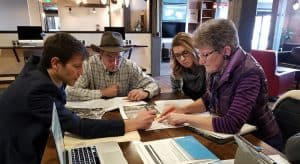During a crisis, an organization’s decision-making process is put to the test. While there is no template for how best to manage a crisis, a general playbook for good governance at any time comes in three parts.
At all times, but especially under duress, it’s important that members of a group — like a board of directors — are aligned about where they’re headed, make decisions that are viewed as legitimate by the rest of the group, and are clear about their roles and how to work together. How well a group can manage a crisis is determined by how well they practice each of these.
Good governance in three parts
These three pillars of good governance are about working together, understanding where you’re going and why. With these three parts of the good governance playbook in place, decision makers strengthen an organization by making it coherent and agile.
In co-op academic circles, these parts are known as: cognition, legitimacy, and strategic interdependencies. As a whole, they mean there is alignment on the direction of the group; decisions by leadership are viewed as legitimate; and everyone understands their place or role.
And (in theory at least) done right these three ingredients are key to achieving good governance. They also suggest an organization or institution with good governance is better positioned to weather a crisis.
Cracks show in a crisis
Generally speaking, a crisis amplifies trends. We’re witnessing this now. The move to online meetings, working from home, and in some respects the dissolution of institutions held dear for decades. Not to mention the transformation of retail, media outlets, cinema, and a wide variety of other events, products, and services.
If an organization or institution’s governance is poor, a crisis will amplify that weakness. Without a coherent vision of the future, clearly defined roles, and legitimacy, the organization will not be able to pivot, adjust, or adapt to the new reality in a timely way.
On the other hand, if an organization is coherent and agile, there is hope. A group that trusts itself, with individuals who know their roles and why they move forward in the way that they do (despite uncertainty), is an organization with good governance.
Of course, making all this work with a group of people is easier said than done. And sometimes it pays to get a little outside help, like Co-operatives First’s Board Basics Workshop.
Three steps to better governance
From our perspective, a key animator is having and defining purpose.
So, start with cognition. Envision what the future will look like, and the role your organization will play. Then ensure everyone’s self interest aligns. Without the alignment of self interest, there is no agreement, no organization, no longevity. And no good to be done.
From there, create pathways between actors — those who make stuff happen. Determine who is responsible for what and how they will be held accountable to the group.
Finally, decide as a group what it means to be transparent and develop ways to collect feedback that inform and include all participants or members in the group. This step both increases legitimacy of the organization as a whole and builds coherence and trust between individuals within the group.
And if you’re having trouble finding a way through a crisis, get outside help. Expert support, like our board workshop for start-up co-ops, can help outline roles, settle on a vision of the future, and find a way forward that ensures decisions have legitimacy.

 Written by
Written by 


